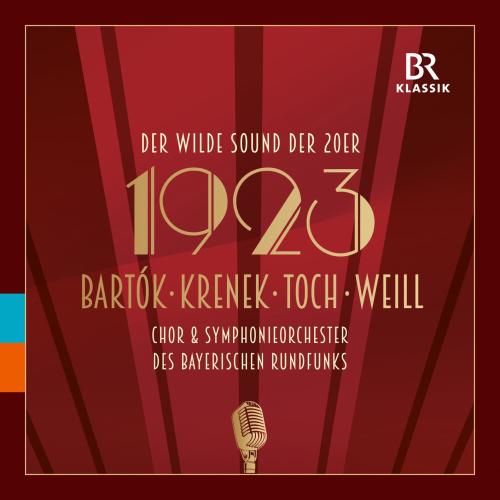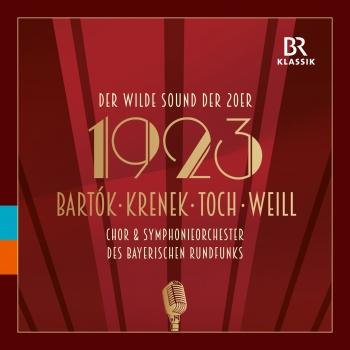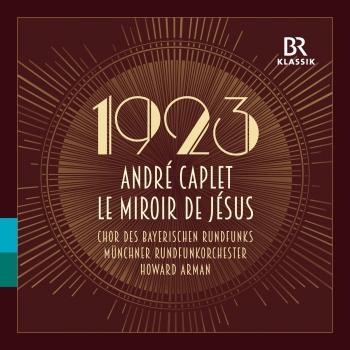
Der Wilde Sound Der 20er Bavarian Chor & Radio Symphony Orchestra & Howard Arman
Album info
Album-Release:
2023
HRA-Release:
20.01.2023
Label: BR-Klassik
Genre: Classical
Subgenre: Vocal
Artist: Bavarian Chor & Radio Symphony Orchestra & Howard Arman
Album including Album cover Booklet (PDF)
- Ernst Toch (1887 - 1964): Tanz-Suite, Op. 30 (Version for Chamber Ensemble & Strings):
- 1 Toch: Tanz-Suite, Op. 30 (Version for Chamber Ensemble & Strings): I. Roter Wirbeltanz 05:18
- 2 Toch: Tanz-Suite, Op. 30 (Version for Chamber Ensemble & Strings): II. Tanz des Grauens 05:56
- 3 Toch: Tanz-Suite, Op. 30 (Version for Chamber Ensemble & Strings): III. Intermezzo 02:31
- 4 Toch: Tanz-Suite, Op. 30 (Version for Chamber Ensemble & Strings): IV. Tanz des Schweigens 04:14
- 5 Toch: Tanz-Suite, Op. 30 (Version for Chamber Ensemble & Strings): V. Intermezzo 02:45
- 6 Toch: Tanz-Suite, Op. 30 (Version for Chamber Ensemble & Strings): VI. Tanz des Erwachens 09:37
- Kurt Weill (1900 - 1950): Frauentanz, Op. 10:
- 7 Weill: Frauentanz, Op. 10: No. 1, Wir haben die winterlange Nacht mit Freuden wohl empfangen 01:45
- 8 Weill: Frauentanz, Op. 10: No. 2, Wo zwei Herzenliebe an einem Tanze gan 01:22
- 9 Weill: Frauentanz, Op. 10: No. 3, Ach wär mein Lieb ein Brünnlein kalt 00:40
- 10 Weill: Frauentanz, Op. 10: No. 4, Dieser Stern im Dunkeln 01:43
- 11 Weill: Frauentanz, Op. 10: No. 5, Eines Maienmorgens schoen 02:01
- 12 Weill: Frauentanz, Op. 10: No. 6, Ich will Trauern lassen stehn 01:26
- 13 Weill: Frauentanz, Op. 10: No. 7, Ich schlaf, ich wach, ich geh 02:56
- Ernst Krenek (1900 - 1991): 3 Gemischte Choere a cappella, Op. 22:
- 14 Krenek: 3 Gemischte Choere a cappella, Op. 22: No. 1, Der Mensch 03:40
- 15 Krenek: 3 Gemischte Choere a cappella, Op. 22: No. 2, Troestung 03:35
- 16 Krenek: 3 Gemischte Choere a cappella, Op. 22: No. 3, Die Roemer 02:31
- Béla Bartók (1881 - 1945): Tanz Suite, Sz. 77:
- 17 Bartók: Tanz Suite, Sz. 77: I. Moderato 03:21
- 18 Bartók: Tanz Suite, Sz. 77: II. Allegro molto 02:23
- 19 Bartók: Tanz Suite, Sz. 77: III. Allegro vivace 03:08
- 20 Bartók: Tanz Suite, Sz. 77: IV. Molto tranquillo 03:06
- 21 Bartók: Tanz Suite, Sz. 77: V. Comodo 01:07
- 22 Bartók: Tanz Suite, Sz. 77: VI. Finale 03:59
Info for Der Wilde Sound Der 20er
The BR-KLASSIK album features recent studio recordings from April 2021 (Toch, Weill) and March 2022 (Krenek) as well as a live recording from the Munich Philharmonie in the Gasteig from March 2017 (Bartók). The album is released as part of the programme focus on "100 Years of Radio", which shows how formative the sound of this century was: in 1923, amidst social upheaval, the age of radio began. The music composed for the new medium reflects the time between modernity and tradition, revolution and republic, jazz and dance music.
29 October 1923 - a date steeped in history. In the midst of a year of political and economic crisis, the age of public radio in Germany was heralded with the first broadcast of the "Berliner Funkstunde" in the attic of an office building on Potsdamer Platz. - Radio offered completely new possibilities for the production and reception of music.
The composers assembled on this album not only profited from these developments, but also played an active role in shaping them. Kurt Weill accompanied the rapid rise of radio as a mass medium as a critical chronicler, reflected on its musical use in countless articles and also composed some radio music at the end of the 1920s. As early as 1924, Ernst Krenek was commissioned to write a "radio blues" and made radio part of the dramatic action in his successful "Zeitoper" "Jonny spielt auf" of 1927. And Ernst Toch, who was extremely interested in the technological and media developments of the time, also composed radio music tailored to the specific possibilities of the medium in 1929 with his "Bunten Suite". The Jewish composer Ernst Toch, who came from Vienna, experienced the crisis year of 1923 in Mannheim, where his "Dance Suite" for flute, clarinet, violin, viola, double bass and percussion op. 30 was premiered on 19 November with great success. In the commissioned work for the expressive dancer Frieda Ursula Back, who choreographed its premiere, Toch was able to realise his interest in cross-disciplinary collaboration and new forms of expression. His virtuoso and imaginative use of instruments is one of the most fascinating aspects of the suite. The "Frauentanz" for soprano, flute, viola, clarinet, horn and bassoon op. 10 by Kurt Weill, written in the summer of 1923, reflects the interest in chamber music formations typical of the time. The decisive factor was not only a new ideal of sound and expression, but also the experience that in times of crisis, pieces with small ensembles had better chances of being performed. The song cycle quickly gained recognition. After its successful Berlin premiere in February 1924, it was published a few months later as the young composer's first work in print and was his most frequently performed piece until 1927. The enormously productive Ernst Krenek had found essential impulses for his work in Berlin/ when the crisis came to a head in the summer of 1923, he returned to Austria, where he composed the "Three Mixed Choirs" a cappella op. 22 on poems by Matthias Claudius in October. Krenek designed the folksong-like models of a lyricist from the epoch of Empfindsamkeit as parables that critically reflect and comment on contemporary experiences and developments. For the festive concert celebrating the 50th anniversary of the unification of the cities of Buda and Pest to form the capital and residence city of Budapest in autumn 1923, Béla Bartók created his "Dance Suite" for orchestra - a "spicy story", as the internationalist-minded composer explained in a private note. His music ingeniously thwarted the cultural-political intentions of the "ultra-Christian-national" patrons. - After chamber music works, a large orchestral work concludes the programme.
Chor des Bayerischen Rundfunks
Symphonieorchester des Bayerischen Rundfunks
Howard Arman, conductor
Cristian Mäcelaru, conductor
Symphonieorchester des Bayerischen Rundfunks
Soon after it was founded by Eugen Jochum in 1949, the Symphonieorchester des Bayerischen Rundfunks (BRSO) developed into an internationally renowned orchestra, its fame continuously expanded and fortified by its intensive touring activities. The orchestra owes its extraordinarily wide ranging repertoire and sound spectrum to the programme preferences of its previous chief conductors as well as to the great flexibility and solid stylistic security of each individual musician.
Fostering new music has an especially long tradition at the Symphonieorchester des Bayerischen Rundfunks with appearances in conjunction with the “musica viva” series, founded in 1945 by Karl Amadeus Hartmann, as one of the orchestra’s main assignments right from the start. At these concerts, Munich audiences have witnessed legendary performances of contemporary works at which the composers themselves generally stood on the podium of the orchestra. These included Igor Stravinsky, Darius Milhaud, Paul Hindemith, Bruno Maderna, Pierre Boulez, Hans Werner Henze, Witold Lutosławski, Krzysztof Penderecki, Cristóbal Halffter, Heinz Holliger, Hans Zender, Karlheinz Stockhausen, Mauricio Kagel, Luciano Berio as well as, more recently, Peter Eötvös.
The Symphonieorchester des Bayerischen Rundfunks was the only German orchestra with which Leonard Bernstein regularly collaborated for many years. In general, many renowned guest conductors, such as Clemens Krauss, Erich and Carlos Kleiber, Charles Munch, Ferenc Fricsay, Otto Klemperer, Karl Böhm, Günter Wand, Georg Solti, Carlo Maria Giulini, Kurt Sanderling, Wolfgang Sawallisch and Bernard Haitink have left indelible imprints on the Symphonieorchester in the past. Today, Riccardo Muti, Esa-Pekka Salonen, Franz Welser-Möst, Yannick Nézet-Séguin, Herbert Blomstedt, Daniel Harding and Robin Ticciati number amongst the significant partners who regularly mount the podium in Munich. For many years, the Symphonieorchester has also pursued approaches to early music and now collaborates regularly with such experts in historical performance practice as Thomas Hengelbrock, Ton Koopman and Giovanni Antonini.
Besides the many performances and recordings in Munich and other cities in the station’s broadcast range, extensive concert tours are central components in the everyday life of the orchestra today. Tours have taken the orchestra to virtually every European country, to Asia as well as to North and South America. It makes regular appearances in New York’s Carnegie Hall and in the renowned concert halls in Japan’s musical capitals. From 2004 to 2019, the Symphonieorchester was the orchestra in residence at the Easter Festival in Lucerne.
A further special feature is the encouragement of up-and-coming young musicians. In conjunction with the ARD International Music Competition, the Symphonieorchester accompanies young musicians both in the final rounds as well as in the symphonic closing concert featuring the prize winners. Since October of 2001 the Academy of the Symphonieorchester des Bayerischen Rundfunks has been doing valuable educational work by preparing young musicians for their later careers and thus building a solid bridge between education and professional activity. Beyond this, the Symphonieorchester maintains an encouragement programme for young people with many activities designed toward the worthy goal of bringing the younger generation closer together with classical music.
The history of the Symphonieorchester is closely intertwined with the names of its previous Chief Conductors, who were always concurrently Chief Conductors of the Chor des Bayerischen Rundfunks.
The founder, Eugen Jochum, led the orchestra for eleven years (from 1949 to 1960.) He built up the orchestra completely with top-grade musicians and established the orchestra’s worldwide reputation on its initial foreign tours. Munich audiences have him to thank for incomparable interpretations of Anton Bruckner’s symphonies. Besides Bruckner Eugen Jochum devoted special attention to the performance of sacred music, and also made regular appearances on the podium of musica viva.
Rafael Kubelík, who headed the orchestra for eighteen years (1961 to 1979), remained closely associated with the orchestra as a guest conductor until 1985. He expanded the repertoire to include works by Slavic composers like Smetana, Janáček and Dvořák, as well as spearheading the cause of 20th century composers such as Karl Amadeus Hartmann and conducting the first Mahler cycle with a German orchestra, which was then recorded. His impulsive, emotional approach to music won the hearts of all the musicians and made the Kubelík era one of the most fruitful ones in the history of the ensemble.
When his already designated successor Kyrill Kondrashin died unexpectedly in Amsterdam, the orchestra turned to Sir Colin Davis, thus gaining a recognized Berlioz specialist as chief conductor (1983 to 1992), who likewise proved an excellent advocate for the Viennese Classical Era as well as the works of English composers, especially Edward Elgar, Michael Tippett and Ralph Vaughan Williams.
From 1993 to 2002 Lorin Maazel led the Symphonieorchester. He set new styles of programming by performing cycles of symphonic works by Beethoven (1995 and 2000), Brahms (1998), Bruckner (1999) and Schubert (2001). He took his leave of his orchestra with a Mahler cycle in 2002.
A new and mutually pleasurable chapter in the history of the Symphonieorchester began in October of 2003 when the acknowledged favorite candidate of all the musicians, Mariss Jansons, assumed his post as the new Chief Conductor of the Chor and the Symphonieorchester des Bayerischen Rundfunks. In no time, he succeeded in creating an atmosphere of the highest artistic standards and a close emotional tie with the orchestra. He regularly received enthusiastic reviews both for his concerts in Munich and the many guest appearances in the leading musical capitals of Europe, America and Japan. Mariss Jansons placed particular emphasis on the works of Beethoven, Bruckner, Mahler, Strauss and Shostakovich. This era, which was particularly fulfilling and significant for both sides, ended with his death on December 1, 2019.
Mariss Jansons continued to expand the orchestra’s vast discography with a high number of CD releases. Completing his Shostakovich cycle with various major orchestras, the Symphonieorchester des Bayerischen Rundfunks contributed Symphonies Nos. 2, 3, 4, 12, 13 and 14. The recording of the 13th Symphony received a Grammy in the category of “Best Orchestral Performance.” Since 2009, the Symphonieorchester des Bayerischen Rundfunks has been releasing CD’s and DVD’s on Bavarian Broadcasting’s own label, BR-KLASSIK.
In a number of different surveys of music critics, the Symphonieorchester des Bayerischen Rundfunks has numbered among the top ten orchestras in the world, in the 2008 orchestra ranking by the British music magazine “Gramophone” (6th place) and in the Japanese music magazine “Mostly Classic” in 2010 (4th place).
The Symphonieorchester des Bayerischen Rundfunks got awarded the “Preis der Deutschen Schallplattenkritik” (Award of German Record’s Review) for Antonin Dvorak’s Symphony No. 9 conducted by Andris Nelsons. In February 2016, the production of the “Missa solemnis” by Ludwig van Beethoven under the direction of Bernard Haitink was nominated for the GRAMMY with choir and symphony orchestra of the Bayerischer Rundfunk. For the recording of the 3rd Symphony by Gustav Mahler under the direction of Bernard Haitink, the orchestra was awarded the BBC Music Award in April 2018. The recording of Bruckner’s Symphony No. 8, conducted by Mariss Jansons received the “Preis der Deutschen Schallplattenkritik” in 2018. Rachmaninoff’s “The Bells”, directed by Mariss Jansons, was awarded in April 2018 by the British “Gramophone Magazine” and the French magazine “Diapason d’Or”. The recording of Shostakovich’s Symphony No. 10 conducted by Mariss Jansons received the “Preis der Deutschen Schallplattenkritik” (Award of German Record’s Review) in 2020.
Mariss Jansons conducted his last concert with the BRSO on November 8, 2019 at the Carnegie Hall in New York. Just a few weeks later, on December 1, 2019, Mariss Jansons passed away in St. Petersburg at the age of 76.
On January 3, 2021, Sir Simon Rattle signed an initial five-year contract as the new Chief Conductor of the Symphonieorchester des Bayerischen Rundfunks and the Bavarian Radio Chorus beginning with the 2023/24 concert season. The conductor, who is appreciated worldwide for his artistic seriousness, compelling charisma, openness and versatility, made his debut with the BR Chorus and BRSO in 2010 with Schumann’s “Paradise and the Peri”. Right from the very beginning, Simon Rattle and the musicians of the BRSO have enjoyed an extraordinarily deep musical understanding, so that the musicians of both ensembles voted overwhelmingly in favor of Simon Rattle as their new chief conductor.
Booklet for Der Wilde Sound Der 20er










